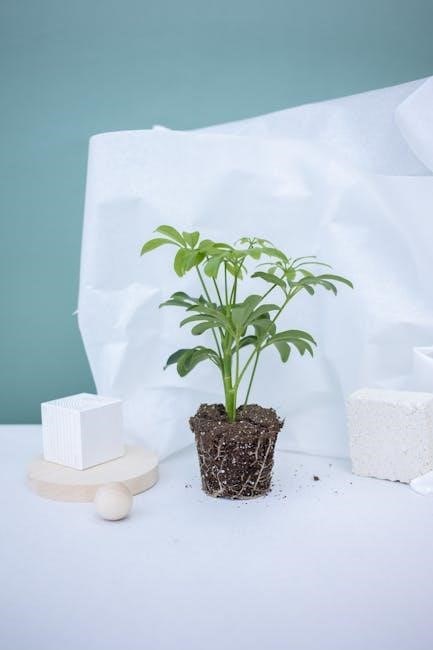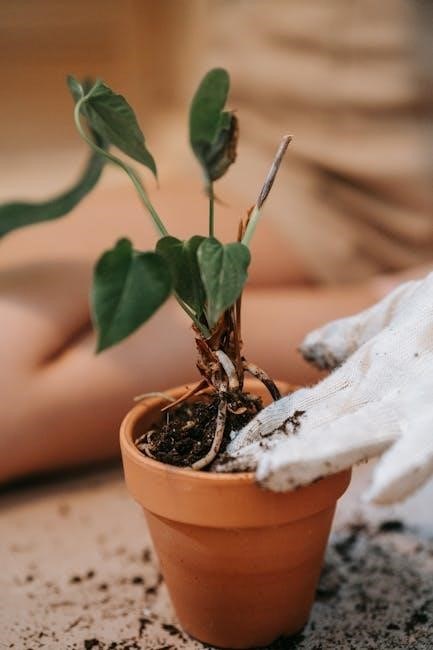Plant systems are essential for understanding how plants function, grow, and interact with their environment. Plant systems worksheets provide interactive tools for learning about roots, stems, leaves, and flowers. These resources help students explore plant structures and their roles in survival, growth, and reproduction. By labeling diagrams and matching functions to plant parts, learners gain a deeper understanding of botany. Worksheets also emphasize the importance of photosynthesis, transportation of nutrients, and support systems in plants. They are valuable educational aids for visual and hands-on learning experiences.
Overview of Plant Systems
Plant systems refer to the organized structures and functions within plants that enable them to survive, grow, and reproduce. The main plant systems include roots, stems, leaves, flowers, and fruits, each performing specific roles. Roots anchor the plant and absorb water and nutrients, while stems provide support and transport resources. Leaves are responsible for photosynthesis, converting sunlight into energy. Flowers and fruits play crucial roles in reproduction and seed dispersal. Worksheets on plant systems, such as the plant systems worksheet PDF, offer interactive learning tools like labeling exercises, diagrams, and matching activities. These resources help students visualize and understand the interconnected functions of plant organs. By studying these systems, learners gain insights into how plants adapt to their environments and sustain life.
Importance of Studying Plant Systems
Studying plant systems is crucial for understanding the fundamental processes that sustain plant life and ecosystems. By examining roots, stems, leaves, and flowers, students learn how plants absorb nutrients, transport water, and perform photosynthesis; This knowledge is essential for agriculture, environmental science, and conservation. Worksheets like the plant systems worksheet PDF provide hands-on activities that enhance comprehension. They also highlight the interconnectedness of plant structures and their roles in energy production and reproduction. Such studies inspire appreciation for botany and its real-world applications, fostering a deeper understanding of nature and our reliance on plants for food, oxygen, and habitat creation. This foundational knowledge benefits future scientists, farmers, and environmental stewards.
Plant Organs and Their Functions
Plants consist of roots, stems, leaves, flowers, and fruits, each serving unique roles in survival, growth, and reproduction; The plant systems worksheet PDF helps identify and understand these organs.
Roots: Structure and Function
Roots are underground plant organs that anchor the plant in soil and absorb water and nutrients. The root system consists of a root cap, meristem, and root hairs. Worksheets like the plant systems worksheet PDF help students label and understand root structures. Roots play a vital role in plant survival by absorbing essential minerals and water, which are transported to other parts of the plant. They also store food and provide structural support. Interactive exercises in worksheets allow learners to explore root types, such as taproots and fibrous roots, and their functions. This hands-on approach enhances understanding of how roots contribute to plant growth and development.
Stems: Support and Transport
Stems are crucial plant structures that provide support and facilitate the transport of essential resources. They hold leaves in optimal positions for photosynthesis and connect roots to other parts of the plant. The plant systems worksheet PDF includes diagrams and labeling exercises to help students understand stem anatomy. Key functions of stems include transporting water, minerals, and sugars through vascular tissues like xylem and phloem. Worksheets often highlight stem types, such as herbaceous and woody stems, and their unique features. Interactive activities allow learners to explore how stems adapt to environmental challenges, ensuring plant stability and growth. These educational tools make complex concepts engaging and accessible for students.
Leaves: Photosynthesis and Transpiration
Leaves are vital organs responsible for photosynthesis and transpiration, essential processes for plant survival. The plant systems worksheet PDF includes detailed diagrams and exercises to help students understand leaf structure and function. Leaves contain chloroplasts, which capture sunlight for energy production, and stomata, tiny pores that regulate gas exchange and water loss. Worksheets often feature labeling activities for leaf parts, such as veins, blades, and petioles, and explore their roles in nutrient transport and energy production. Interactive exercises also highlight how leaves adapt to environmental conditions, ensuring efficient photosynthesis and water management. These resources provide a comprehensive way to study the critical functions of leaves in sustaining plant life and overall ecosystem health.
Flowers: Reproduction and Attraction
Flowers are central to plant reproduction, attracting pollinators and facilitating seed production. The plant systems worksheet PDF offers engaging activities to explore flower structure and function. Worksheets include labeling exercises for petals, sepals, stamens, and pistils, emphasizing their roles in pollination and fertilization. Interactive tools also highlight how flowers attract pollinators through color, scent, and nectar. Students learn about the life cycle of flowers, from bud to seed, and their importance in plant diversity. These resources provide a hands-on approach to understanding the reproductive processes of plants, making complex concepts accessible and engaging for learners of all levels.
Fruits and Seeds: Development and Dispersal
Fruits and seeds are vital for plant reproduction and dispersal, ensuring the survival of species. The plant systems worksheet PDF includes activities that explore the development of fruits from ovaries and the formation of seeds from ovules. Worksheets detail how fruits protect seeds, provide nutrients, and aid in dispersal through various mechanisms, such as wind, water, and animal consumption. Interactive exercises also cover seed anatomy, including the embryo, endosperm, and seed coat. By examining these processes, students gain insights into the life cycle of plants and the ecological roles of fruits and seeds in different environments.


Plant System Functions
Plant system functions include water transport, nutrient absorption, photosynthesis, and support. Worksheets provide exercises on these processes, enhancing understanding of how systems work together for plant survival and growth.

Transportation of Water and Nutrients
The transportation of water and nutrients in plants is a critical function of the root and vascular systems. Roots absorb water and minerals from the soil, which are then transported through the xylem to the stem and leaves. This process is essential for photosynthesis and cell function. Worksheets often include diagrams and labeling exercises to illustrate how these systems operate. Activities may involve matching plant parts to their roles in transport or answering questions about the movement of nutrients. These exercises help students understand the vital role of efficient water and nutrient distribution in plant growth and survival.
Photosynthesis and Energy Production
Photosynthesis is the process by which plants convert light energy into chemical energy, producing glucose for growth and development. This process occurs primarily in the leaves, where chlorophyll in chloroplasts captures sunlight. Worksheets often include diagrams of leaf structures, such as stomata and chloroplasts, to help students understand the role of each part in photosynthesis. Activities may involve labeling the steps of photosynthesis or matching plant parts to their functions in energy production. These exercises emphasize the importance of light, water, and carbon dioxide in the photosynthetic process. By studying these concepts, students gain insight into how plants sustain themselves and support life on Earth through energy production.
Support and Stability
Plants rely on their structural systems to maintain support and stability, enabling them to grow upright and withstand environmental forces. The stem acts as a scaffold, holding leaves in optimal positions for photosynthesis and supporting flowers and fruits. Roots anchor the plant in the soil, preventing it from being uprooted. Worksheets often include diagrams of stem and root structures, highlighting tissues like xylem and sclerenchyma, which provide rigidity. Activities may involve labeling these structures or matching plant parts to their stabilizing functions. These exercises help students understand how plants maintain their structure while transporting essential nutrients and water; This knowledge is crucial for appreciating plant resilience and growth.

Reproduction and Growth
Plant reproduction and growth are vital for their life cycle, ensuring the continuation of species. Flowers play a central role in reproduction, producing pollen and seeds. Worksheets often focus on flower anatomy, such as petals, sepals, stamens, and pistils, explaining their roles in pollination. Seeds and fruits develop from fertilized ovaries, dispersing to propagate new plants. Activities in plant system worksheets may involve labeling flower parts, matching reproductive structures to their functions, or describing seed dispersal methods. These exercises help students understand how plants reproduce and grow, emphasizing the importance of flowers, fruits, and seeds in sustaining plant populations and ecosystems.


Types of Plant Systems
Plant systems are categorized into root and shoot systems, each with distinct structures and functions. Root systems, like taproots and fibrous roots, vary in structure and type. Shoot systems include stems and leaves, essential for photosynthesis and support. Worksheets often include diagrams and labeling exercises to differentiate these systems, helping students understand their roles in plant survival and growth. Interactive activities enhance comprehension of plant diversity and specialization, making complex concepts accessible through visual and practical learning tools.
Root System: Structure and Types
The root system is a vital part of plant anatomy, anchoring plants and absorbing water and nutrients. Worksheets on root systems highlight two main types: taproot systems, characterized by a single large root, and fibrous systems, featuring a network of small roots. These structures are often illustrated in diagrams for labeling exercises. The taproot system, found in plants like carrots, stores food, while fibrous systems, seen in grasses, enhance nutrient absorption. Understanding root system types is crucial for grasping plant adaptation and survival strategies. Interactive activities in worksheets help students explore these differences, reinforcing knowledge through hands-on learning and visual aids.
Shoot System: Stem and Leaves
The shoot system consists of stems and leaves, playing a central role in plant growth and development. Stems provide structural support, holding leaves in optimal positions for light exposure, and act as conduits for water, nutrients, and sugars. They also store food in some plants, like bamboo. Leaves are specialized for photosynthesis, containing chloroplasts that convert sunlight into energy. Worksheets often include diagrams of leaf structures, such as stomata and veins, for labeling exercises. Interactive activities help students understand how stems and leaves work together to sustain plant life. These resources emphasize the shoot system’s role in nutrient transport and energy production, making complex concepts accessible through visual and hands-on learning tools.
Benefits of Using Plant Systems Worksheets
Plant systems worksheets offer interactive learning through labeling and matching exercises, enhancing understanding of plant structures and functions with visual and hands-on activities.
Interactive Learning Tools
Plant systems worksheets offer engaging interactive learning tools that make botany accessible and fun. Features like drag-and-drop labeling, matching games, and fill-in-the-blank exercises encourage active participation. These tools help students connect plant structures with their functions, fostering a deeper understanding. Interactive diagrams allow learners to explore root systems, leaf anatomy, and flower parts in detail. Real-time feedback and scoring systems motivate students to complete tasks accurately. These dynamic resources cater to visual and kinesthetic learners, making complex concepts easier to grasp. By integrating technology with traditional learning methods, plant systems worksheets create a modern, effective way to study botany. They are ideal for classroom use or self-study, promoting a hands-on approach to learning about plants.

Visual Aids for Better Understanding
Plant systems worksheets are rich in visual aids, providing clear diagrams and illustrations of plant structures. These visuals simplify complex concepts, making it easier for students to comprehend how roots, stems, leaves, and flowers function. Detailed cross-sections of roots and stems help learners understand transport systems, while labeled diagrams of leaves highlight photosynthesis processes. Color-coded charts and infographics further enhance learning by visually connecting plant parts to their roles. These visual tools are particularly beneficial for students who learn best through imagery, ensuring that abstract ideas become tangible and memorable. By incorporating high-quality visuals, plant systems worksheets create an engaging and effective learning experience for students of all ages.

Components of a Plant Systems Worksheet
A plant systems worksheet typically includes labeling exercises, matching functions to plant parts, and short answer questions. These components help students understand and retain key concepts effectively.
Labeling Exercises
Labeling exercises in plant systems worksheets are interactive tools designed to help students identify and learn the different parts of a plant. These exercises typically include diagrams of plant structures such as roots, stems, leaves, flowers, and seeds. Students are required to label each part accurately using provided terms or by filling in the blanks. This hands-on approach enhances visual learning and reinforces memory retention. By associating each labeled part with its function, students gain a clearer understanding of how plants operate as a whole. Such exercises are particularly effective for visual learners and serve as a foundational step in mastering plant anatomy.

Matching Functions to Plant Parts
Matching functions to plant parts is a key component of plant systems worksheets, designed to enhance understanding of plant anatomy and physiology. Students are typically presented with a list of plant parts, such as roots, stems, leaves, flowers, and seeds, alongside their corresponding functions. By correctly pairing each part with its function, learners develop a deeper grasp of how plants operate. For instance, roots are matched with absorbing water and nutrients, while leaves are linked to photosynthesis. This exercise strengthens critical thinking and reinforces the importance of each plant organ in overall plant survival and growth. It also prepares students for more advanced topics in botany and ecology.
Short Answer Questions
Short answer questions in plant systems worksheets are designed to assess students’ understanding of specific concepts in plant anatomy and physiology. These questions require concise yet detailed responses, encouraging critical thinking and the ability to articulate knowledge clearly. Examples include: “What is the primary function of the root system?” or “Explain the process of photosynthesis and its importance to plant survival.” Such questions help students reinforce their learning by applying it to real-world plant biology scenarios; They also prepare learners for more advanced studies by fostering analytical skills and the ability to communicate scientific ideas effectively. Answers are typically brief, focusing on clarity and accuracy.
Understanding plant systems is crucial for comprehending how plants function and survive. Plant systems worksheets provide interactive and practical tools for effective learning and student engagement.
Plant systems are fundamental to understanding how plants function, grow, and adapt to their environment. Roots anchor plants, absorb water, and nutrients, while stems provide structural support and transport essential materials. Leaves are vital for photosynthesis, converting sunlight into energy, and regulating transpiration. Flowers and fruits play roles in reproduction, attracting pollinators, and dispersing seeds. Worksheets on plant systems offer engaging tools for learning, including labeling exercises, matching functions to parts, and short-answer questions. These resources help students connect theoretical knowledge with practical observation, fostering a deeper appreciation for botany and its importance in ecosystems. Continued exploration of plant systems enhances understanding of their critical roles in sustaining life on Earth.
Encouragement for Further Study
Exploring plant systems opens a gateway to understanding the intricate mechanisms of life on Earth. Delving deeper into topics like photosynthesis, nutrient transport, and reproduction can unlock fascinating insights into botany. Encourage students to engage with plant systems worksheets, conduct simple experiments, and observe plants in their natural habitats. This hands-on approach fosters curiosity and a deeper appreciation for the natural world. By pursuing further study, learners can gain practical skills in gardening, environmental science, and even contribute to sustainable practices. The study of plant systems is a rewarding journey that nurtures both knowledge and a connection to the environment, inspiring future discoveries and applications in various fields.